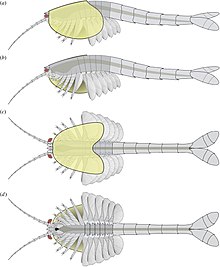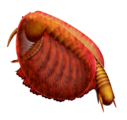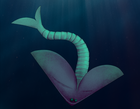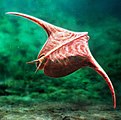Hymenocarina
| Hymenocarina Temporal range:
| |
|---|---|

| |
| Diagram of Waptia | |

| |
| Fossil of Canadaspis perfecta | |
| Scientific classification | |
| Domain: | Eukaryota |
| Kingdom: | Animalia |
| Phylum: | Arthropoda |
| Clade: | Mandibulata |
| Order: | †Hymenocarina Størmer, 1944 |
| Genera | |
| |
| Synonyms | |
|
Canadaspidida Novozhilov in Orlov, 1960 | |
Hymenocarina is an
Taxonomy
Hymenocarines are characterized by the combination of following characters: bivalved, convex carapace covering cephalothoracic region; cephalothorax bearing multisegmented antennules and rounded mandibles, alongside post-maxillular limbs with spiny, subdivided basis and endopods with well-developed terminal claws; absence of appendages between antennules and mandibles; median sclerite and lobate protrusions located between compound eyes; posterior tagma (abdomen) with ring-like segments and terminated by a pair of well-developed caudal rami.[2][1]
Based on the interpretation of simple head region that possess only a few segments and appendages, hymenocarine taxa were thought to be part of the upper stem-group euarthropods in early and mid 2010s.[3][4][5][6][7][8][9][10] They later became widely accepted as mandibulates (jawed arthropods) after the discovery of their mandible-bearing mouthparts in late 2010s.[2][1][11][12] Since then, most phylogenetic analysis suggest hymenocarines represent part of the mandibulate stem-group,[2][13][1][14][15][16][17][18] with some results suggest a rather crownward position such as stem-pancrustaceans,[1][19][20][18] stem-myriapods,[1] stem-hexapods[16] or somewhere in-between the former taxa.[21]
Several subgroups within the order are recognised, including Waptiidae
Cambrian bivalved arthropods are now recognised to be a
Diversity
-
Life restoration of Waptia
-
Life restoration of Canadaspis laevigata
-
Only 2 cm-long Fibulacaris is suggested to have swum upside down
-
Large-sized Balhuticaris shows extreme multisegmentation with over 100 segments
-
Unlike other taxa, eyes of possible hymenocarine Erjiecaris were probably placed over carapace
-
The carapace of possible hymenocarine Pseudoarctolepis had wing-like projections
The group was very diverse in shape, with some forms like
References
- ^ PMID 30110460.
- ^ S2CID 4454526.
- PMID 23055069.
- S2CID 86725173.
- ISSN 0024-1164.
- PMID 24077329.
- S2CID 7751936.
- PMID 27989966.
- PMID 29391458.
- PMID 29784780.
- S2CID 189926344.
- S2CID 225478171.
- PMID 29262772.
- S2CID 226248177.
- S2CID 233952670.
- ^ S2CID 234812878.
- ^ S2CID 236284813.
- ^ S2CID 246779634.
- S2CID 202550431.
- PMID 31914921.
- ^ S2CID 218675348.
- PMID 36483757.
- ^ S2CID 250057171.
- ^ S2CID 247123967.
- PMID 31827867.
- .
- JSTOR 2395403.
- PMID 31827867.








